Hangin' Out as Usual!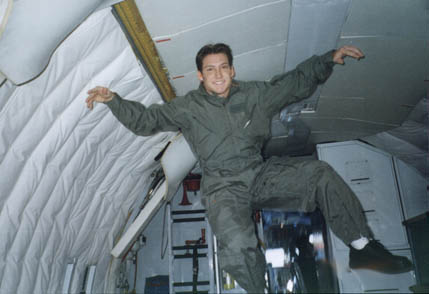
|
|
 |
being weightless is an amazing feeling and that astronauts must have a blast being able to constantly float around for days on end! I can't wait for space travel to become a common event for everyone, that way others would better understand my explanations of what it feels to be weightless (and maybe I could go up and have fun being weightless again). NASA achieves weightlessness by flying a KC-135 aircraft nicknamed the Weightless Wonder or Vomit Comet in a special trajectory. The shape is that of a parabola, or a sine wave. The aircraft starts by climbing steeply at about a 45 degree angle. Then the pilot noses the plane over and dives toward the ground also at about a 45 degree angle. This induces 2 Gs on the body when pulling out of the dive and then 0 Gs when pitching over and diving. This maneuver is usually performed 40 times in a row with short 5 minute breaks every 10 parabolas for every one to catch their breath! Due to safety limits, the altitude that is dropped is only a few thousand feet making the 0 G duration approximately 25 seconds long (not nearly enough). |
|
to describe. It is similar to the freedom found in swimming. You are free to move in any direction and have any orientation, however, unlike swimming, there is no friction or gravity to slow you down or pull in any direction (also unlike swimming, there is no desire to go skinny floating with vomit obstacles to avoid and sudden 2-g landings)! Anyway this leads to some interesting first flights. When you are weightless for the first time your brain does not know what to think. Suddenly you feel no pressure on your body and everything extends or curls to their natural positions. Your brain has never experienced something like this before and is very confused. |
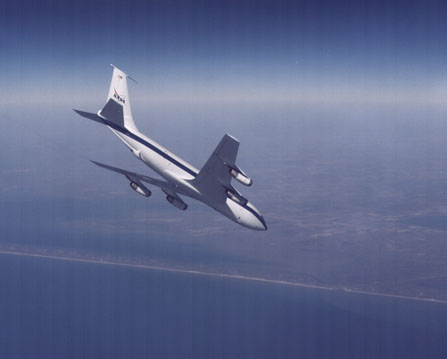
|
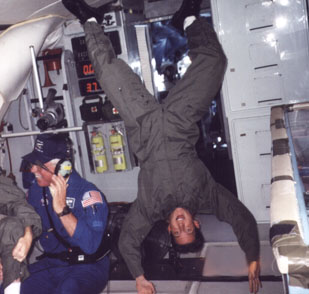 |
explain how your body senses gravity. You are welcome to skip this part if you do not want to hear about the human physiological effects of gravity or the lack of it. There are two methods that the humans detect accelerations. The first are called semi-circular canals, which detect rotational accelerations. The second, and the ones that are affected by being weightless, are called odoliths and they detect linear accelerations and let us know our orientation. The odoliths are little pieces of calcium that sit on top of hairs in the inner ear. When you accelerate the odoliths causes the hairs to bend and the bending direction and magnitude lets us know the direction and degree to which we are accelerating. Since we experience the acceleration of gravity constantly these hairs are slightly bent forward. This means when gravity is taken away the hairs extend slightly and it produces a response as if you are hanging upside down. |
|
that is, due to being weightless for the first time, not the paragraph above. The first thing that you think is that the whole plane was suddenly turned upside down. Your eyes believe your brain for a while telling you that you should grab onto something before you fall down on your head . . . Soon logic prevails and you realize that your not upside down and you are balanced in midair, not going anywhere! This is pretty neat, however, you soon get to thinking that it would be even more neat to fly to another part of the plane! You give a push off the floor to check out the ceiling or the opposite wall. Suddenly you are going like a bat out of hell and it is all you can do to put your hands up before you crash into the wall! Luckily, the whole cabin is padded and all edges are rounded to deaden your blow, or there would probably be a lot of people hurt from playing around in weightlessness! |
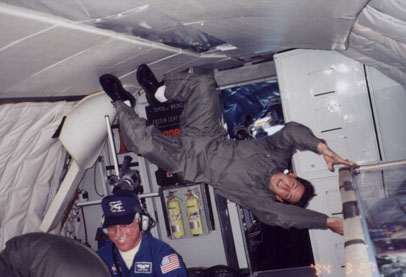
|
 |
After a few tries you start getting the hang of moving without any restrictions and you are floating all over the place feeling like you are the master of the sky! That is, until you are not careful and you find yourself in the center of the cabin and can't touch anything. When you find yourself in this predicament it is a very strange. You can't move by your own will, but you try anyway. A common reaction is concentration is lost, you loose orientation, and begin to kick and flail as if you are swimming to the other side of a swimming pool. This only makes it worse because usually other flyers and equipment get hit, kicked, or run in to (this usually results in you owing the people hit a beer later that night). And you begin thinking what is all this equipment doing here restricting my flying anyway? Oh ya, the experiment part of the flight . . . well, we'll get to that part soon enough, there are still a few more fun things to talk about. |
|
recommend to do when there are extra parabolas to have fun. One is to fly down the length of the plane, which is about the same size as a Boeing 707. Also fun, is to lay on the floor, then push off while torquing yourself into a spin. You end up in the middle of the cabin quickly spinning about the long axis of your body! You can also induce some fun spins by grabbing a strap on the floor or ceiling and twisting them, causing your body to spin in the opposite direction. |

|

You can see the clouds fly by as you head up and then the sparkling water and boats as you dive back down. Oh, I suppose I should mention that the plane is flown over the Gulf of Mexico out of Johnson Space Center in Houston. The most fun thing to do would have to be, being spun by NASA's flight crew. There is a flight physician, camera people, and a couple people watching to make sure everyone is safe and helping those who don't feel good. The trick is tucking into a ball and then having one of the NASA guys strap his feet into the floor. Then have him spin you real fast! It is amazing! 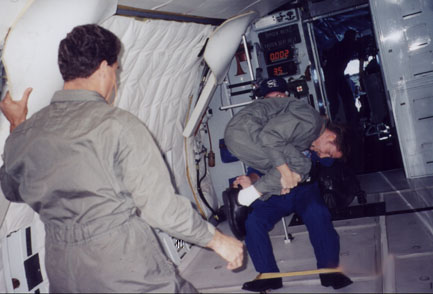
|
|
|
work must also be done . . . NASA flies the KC-135 to take advantage of weightless conditions for testing systems and procedures that could take place in space. This ranges from small satellite formation flying and materials testing, to astronaut training and space systems testing. To test systems on the KC-135, college teams can send in a proposal to be selected or companies can pay NASA to test their systems. I was fortunate enough to fly both ways. The first time I flew was in my senior year of college with a senior design team in the spring of 2001, the design team can be seen to the right with the project bolted down to the floor. We designed an automatic watering system for growing plants in space around a ceramic porous tube instead of using soil. The system would prime and pressurize the porous tube. The pressure would correspond to a flow rate of water out of the pours to plants. This involved designing, building, and testing the fluid system with pumps and solenoid valves, software, and electronic circuit boards. The reason this needed to be tested in a microgravity is because we started with a dry system and had to replace the air with water. This is difficult to do in space since buoyancy is a gravity dependant process, making it so that the water and air do not separate. It was a great feeling to see the system work as planned in our microgravity tests. I was able to fly one day on the aircraft for this test and did not have much time to play around and get used to floating. |

|
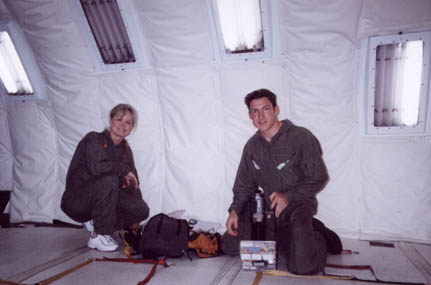 |
the spring of 2002. I was testing some hardware for the company I work for BioServe Space Technologies. We design, build, and operate payloads that fly on the Space Shuttle and Space Station. I tested some multi-chambered tubes we use for performing cell growth experiments. I also tested other multi-chambered tubes that will be used to encapsulate astronaut-harvested plants with an RNA fixative. This allows the RNA to be analyzed and directly compared to Earth grown plants to check for differences. I was supposed to test on the KC-135 for 4 days, but a engine malfunction canceled the second two days. Some good results were achieved in the first two days, in which I again had little time for floating around and having fun. I flew with a Marshall Space Flight Center employee, Debra, who wanted to fly and volunteered to help. The two of us are shown on the left with the bag of tubes to test and a hand-held back light device with a camera mounted to it to capture the activation of the tubes. |
|
of the plant fixative tubes since all the test objectives were not met in the second set of flights due to the cancellation of the last two flights. This meant that I had a lot of time to have fun throughout the 4 days of testing. I was the only person on my flight team that time. I bet you are sitting there and saying "that's all well and good, but I thought is was called the vomit comet? Tell us about the gross stuff!" Yep, it's true, most people get sick to one degree or another. Personally I got sick 3 out of the 7 times I flew. It was always on the first day of flying. Whenever I flew consecutive days I was always fine after getting used to floating on the first day. On two of the days I got sick, I was down and out for just a couple minutes but back up and having fun or working in no time (I'll explain the last time in a moment). Some people never recover and spend the entire 2 hour flight in utter misery. |
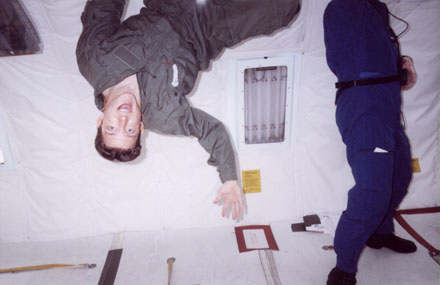
|
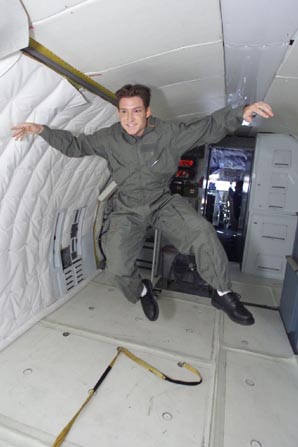 |
a lot of other people around you get sick making the smell of the plane less than pleasant, plus it is hot and stuffy in the cabin. The other reason why you get sick is due to overloading your senses in your inner ear. Yep, a little more of the physiology details. Surprisingly you do not get sick due to the 0g parts of the flight, it is more from the 2g parts. If you move your head around a lot in 2gs your odoliths are bending your inner ear hairs a lot more than they are used to. Also with turning your head at the same time sends strong signals from your rotational acceleration inner ear sensors and your body just flat does not like that type of movement! If your head is held still in the 2g parts of flight there is a much better chance of not getting sick. NASA provides a drug called ScopeDex a combination of Scopemine and Dexidrin, or something like that. It works very well, however has some interesting side effects. It can make you both hyper and drowsy at the same time. It can also dry your mouth out and give you a head ache, not good if you plan on operating heavy machinery at any point during the day. Unfortunately, this made it hard on me during the second set of flights. I would have to wake at 5:30 to do last minute preparation of the hardware. We would then load the plane at 9:00 and finish flying around 12:00. I would then have 10 hours of hardware refurbishment that night while feeling the effects of the drugs, not a very fun time. Luckily I only had about 4 hours of refurbishment on the last set of flights. This brings me back to the second time I got sick. For the first day of the second set of flights, I thought I would outsmart motion sickness and the bad side effects of the ScopeDex by taking Dramimine, an over the counter motion sickness drug . . . not a good idea. The Dramimine did not work at all and I was sick only 6 parabolas into the 40, and did not ever fully recover that flight . . . Stick to the ScopeDex and avoid heavy machinery! |
|
If you would like to see any other pictures of specific parts of the experience, or want higher resolution copies of what are on the web site, just let me know. Also, don't hesitate to ask if you have any questions. jon.pineau@colorado.edu Check out some pictures from other trips here |
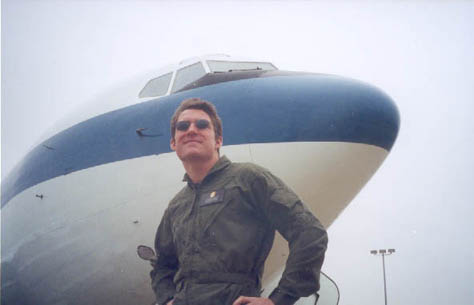
|